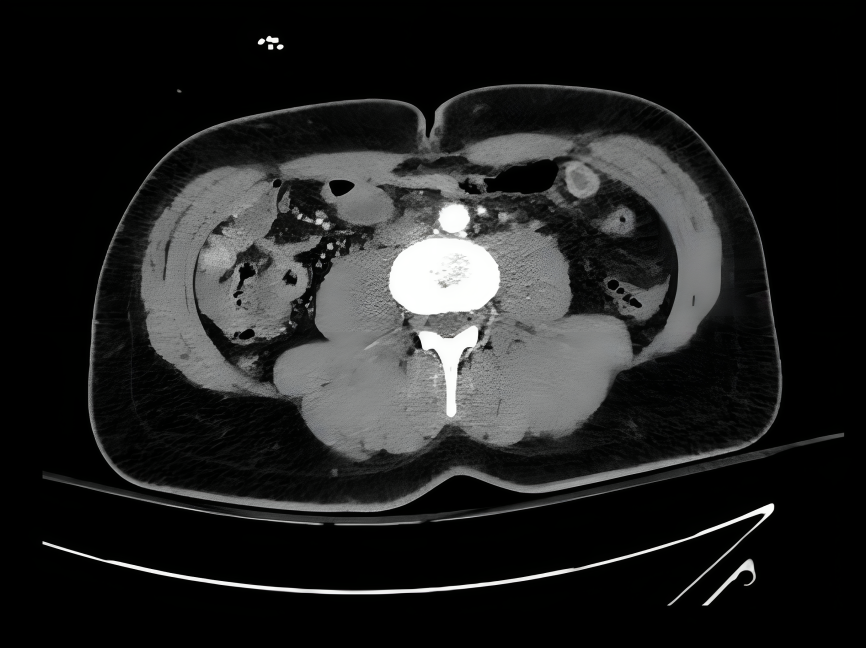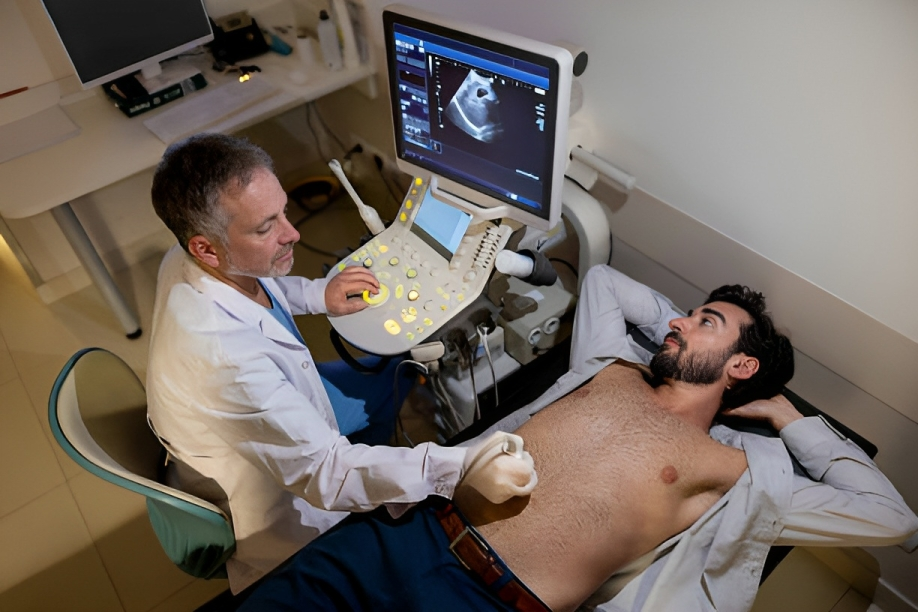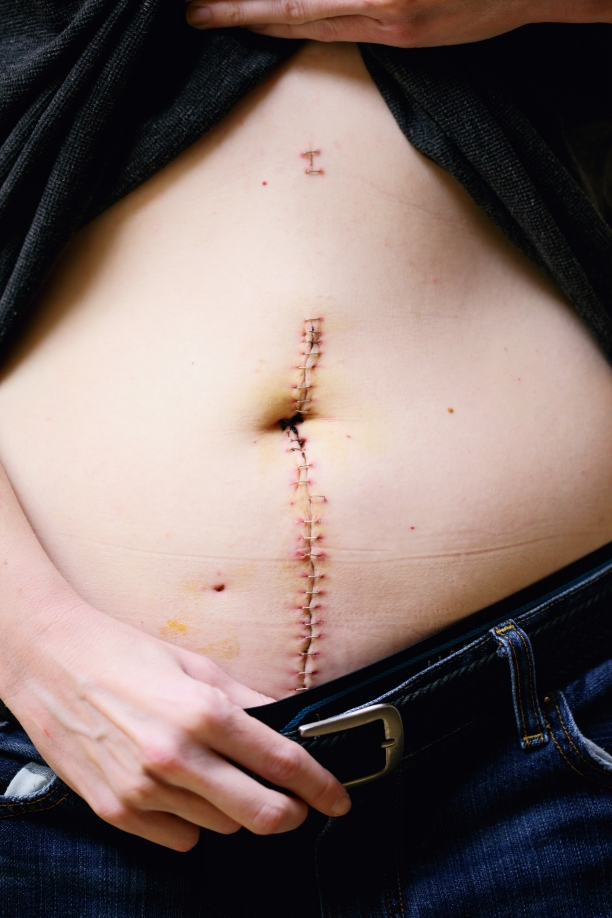Exploratory Laparotomy, also known as celiotomy, is a major abdominal surgery. In this surgery, your abdomen is incised in a midline position to visualize the whole abdominal cavity to diagnose the ongoing pathology in your abdominal cavity.
What is Exploratory Laparotomy?
Laparotomy is derived from two Greek words: Lapra, which means flank, and tomy, which means cut. Laparotomy is both a diagnostic and therapeutic procedure. Your abdomen has multiple organs. This surgery is done to find the problem in your abdominal cavity that can not be diagnosed by routine laboratory testing.
This invasive surgical procedure can be performed in adults and children, depending on the severity of the disease. It can also be performed in emergency conditions in case of trauma in which there is a serious injury to the abdominal viscera.
In the United Kingdom (UK), it is a widespread surgical procedure. About 30000-50000 exploratory laparotomies are performed every year.1Fn, J. W. R. M. (2022, July 22). Exploratory Laparotomy: Overview. Verywell Health. https://www.verywellhealth.com/what-is-an-exploratory-laparotomy-surgery-3157278
Indications of Exploratory Laparotomy
The indication of exploratory laparotomy is reduced due to the introduction of minimally invasive surgical procedures (exploratory laparoscopy). However, there are some indications of exploratory laparotomy. These are:
- Acute onset of abdominal pain suggests intra-abdominal pathology like Intestinal obstruction, Crohn’s disease, and intestinal TB
- Abdominal trauma followed by hemoperitoneum (blood in peritoneum) and hemodynamic instability
- Chronic abdominal pain
- Ovarian carcinoma
- Endometriosis
The decision to perform open abdominal surgery or minimally invasive surgery depends upon the condition of the patient and the severity of the disease. Additionally, open surgery is preferred in the following:
- In emergency situations, e.g., trauma
- When the patient is hemodynamically unstable
- When the doctor wants to visualize your entire abdominal cavity
- When laparoscopy is not possible2Niroshini Rajaretnam, Okoye, E., & Burns, B. (2023, May 17). Laparotomy. Nih.gov; StatPearls Publishing. https://www.ncbi.nlm.nih.gov/books/NBK525961/

Contraindications of Exploratory Laparotomy
There are no absolute contraindications of exploratory laparotomy. However, some comorbidities make you unfit for general anesthesia. These are the following:
- Abnormal blood clotting profile
- Advanced malignancy
- Severe respiratory illness
- Severe cardiac failure
- Peritonitis followed by severe sepsis and organ failure3Mascrs, V. K. M. M. P. F. F. F. F. M. (n.d.). Exploratory laparotomy technique: an open exploration of the abdomen, complications. https://emedicine.medscape.com/article/1829835-technique#c3?form=fpf
Why is Exploratory Laparotomy Performed?
Exploratory laparotomy is performed to find the cause of the presenting symptoms. In this procedure, your surgeon explores the following viscera:
- Your entire gut (small and large intestine)
- Stomach
- Liver
- Gallbladder
- Pancreas
- Spleen
- Appendix
- Kidneys
- Urinary bladder
- Lymphatics
- Ovaries in female4Exploratory laparotomy. (n.d.). Saint Luke’s Health System. https://www.saintlukeskc.org/health-library/exploratory-laparotomy
Steps of Exploratory Laparotomy
Laparotomy is a large surgical procedure that can be performed in an emergency to save the life of the patient and can also be done for elective cases. This surgery is done in the hospital by your surgeon under full aseptic measures. The steps of exploratory laparotomy are the following:
How will you prepare for the Surgery?
The day before surgery, you will meet your concerned surgeon. He will examine you and advise you on some tests to check your fitness. These tests are:
- Complete blood count (CBC) to check your hemoglobin status because it is an invasive surgery.
- White blood cell count (WBCs) to check your infection status
- Viral markers
- Random blood sugar level (RBS)
- Renal function test and renal parameters (RFTs and RPM)
- Liver function tests (LFTs)
- Chest x-ray
- X-Ray abdomen erect
- ECG
- Cross-matching

Inform your doctor if you have allergies to some medications and all the medications you are taking. After getting the results, you have to stay in the hospital a day before surgery under observation.
If you are taking some medications like blood thinners, ask your doctor because these medications can affect your surgery.
Anesthesia Fitness:
You will be sent to the anesthesiologist for anesthesia fitness. He will examine you, check your test, and allow you to fit for surgery. After getting anesthesia fitness, your doctor will give you instructions you must follow. These are:
- Stay in the hospital
- Don’t eat after 6-8 hours because if your stomach is full, it can cause aspiration pneumonia
- Remove your jewelry and bangles before entering the operation theater
- Reach the operation theater at the given time
- Shave and clean the respective area before reaching the operation theater.
What happens on the day of the Surgery?
On the day of surgery, you will reach the operation theater in the morning. Before entering into OT, The operation theater assistant will give you a sterilized OT dress to wear. After that, you will enter the operation theater.
In the operation theater, your doctor will insert an intravenous line into your hand for general anesthesia. Your surgeon will perform an allergic test before giving intravenous antibiotics. He will inject a small amount of antibiotic subcutaneously and wait for 3-5 minutes to check the skin induration. After ensuring your safety, an anesthetist will sedate you by giving general anesthesia. Finally, after general anesthesia, your surgeon will perform your surgery. The steps of surgery are:
- Positioning the patient on the OT table for surgery is the first step.
- Your doctor will disinfect your skin by applying a pyodine solution to avoid infection.
- He will give a long vertical midline incision on your abdomen.
- He will retract your skin, fat, and muscles to expose the abdominal contents. He will open your abdominal cavity and examine it thoroughly to locate the problem.
- The surgeon will also secure the hemostasis (bleeding) during the surgery
- He will make sure to preserve arteries and nerves.
- After exploring your abdomen and locating the problem, he will perform certain surgical procedures to rectify the issue.
After completion of the procedure, your doctor will secure your hemostasis, close your abdomen with the help of different stitches, and apply a dressing to your surgical area.5Exploratory laparotomy – what you need to know. (n.d.). Drugs.com. https://www.drugs.com/cg/exploratory-laparotomy.html
Types of Incisions in Laparotomy:
There are different types of approaches through which your surgeon gains entry into your abdomen. These are the following:
Midline Incision
Midline incision is the most common approach that gives access to all abdominal organs to your surgeon. In this approach, a large incision is given along the linea alba close to your umbilicus (belly button). Your surgeon can limit the size of the incision depending on the pathology.
Paramedian Incision
This incision is also the same as a midline incision but lateral to the linea alba. It is preferred in cases where retroperitoneal structures are involved, e.g., kidney and adrenal glands. Precautionary measures are taken in this approach to avoid damage to the nerve and vessels.
Transverse Incision
This incision is given transversally on the lateral side of the umbilicus. It is also a common approach that gives broad access to your abdominal organs, causes the least damage to your neurovascular bundles, and heals well.
Subcostal Incision
This incision is also known as the Kocher incision and is given in epigastric regions. It allows access to the spleen, gallbladder, and pancreas.
Pfannenstiel Incision
This incision is also known as a bikini incision to give access to your pelvic cavity. Care must be taken during this approach to avoid damage to the bladder.6Rajaratnam, N. (2023, May 17). Laparotomy. StatPearls – NCBI Bookshelf. https://www.ncbi.nlm.nih.gov/books/NBK525961/
What happens after the Surgery?
After surgery, your doctor will send you to the intensive care unit (ICU) for observation. After your recovery, you will move back to the general surgical Ward. You may feel pain at the surgical site. However, some patients can also have a sore throat after surgery due to the endotracheal tube that is placed during anesthesia. You may also feel nausea due to anesthesia.
Your doctor will prescribe some medication to control post-surgical pain and infection. These medicines include the following:
- Opiates to relieve your pain
- Paracetamol to avoid fever
- Antibiotics to avoid infection
- Antiemetics to avoid vomiting
- Proton pump inhibitors (PPI)
- Electrolytes to maintain your body fluid level7Bozzay, J. D., Walker, P. F., Schechtman, D. W., Shaikh, F., Stewart, L., Tribble, D. R., Bradley, M. J., & Infectious Disease Clinical Research Program Trauma Infectious Disease Outcomes Study Group (2021). Outcomes of Exploratory Laparotomy and Abdominal Infections Among Combat Casualties. The Journal of Surgical Research, 257, 285–293. https://doi.org/10.1016/j.jss.2020.07.075
Postoperative Care after Exploratory Laparotomy
Post-operative care is necessary for fast recovery. For this purpose, your doctor gives you instructions you must follow. These are:
- Change the dressing on alternate days and take good care of your wound
- Take medicine regularly
- Mobilize yourself to avoid bed sores and edema
- Chest physiotherapy to prevent chest infection
- Use a soft diet to avoid constipation
- Avoid fatty and spicy food
- Avoid straining activities
- Avoid strenuous exercises
When to call your Doctor?
Immediately call your doctor if you notice the following symptoms:
- Signs of infection around the surgical area (warm, red, and tender area)
- High-grade fever with chills
- Bleeding from the wound
- Persistent cough
- Persistent constipation
- Nausea and vomiting
- Incontinence
- Diarrhea
- Chest infection
- Shortness of breath
- Edema
- Abdominal distension
Exploratory Laparotomy for Endometriosis
After the introduction of minimally invasive surgery called laparoscopy, Laparotomy is rarely used for endometriosis.
Procedure:
In this procedure, your doctor will give a horizontal incision the same as a C-section called a bikini incision, that allows access to your pelvic organs. After opening the abdomen, your surgeon removes the mass (endometriomas) from the ovaries. Your surgeon may also remove your ovaries (oophorectomy) along your fallopian tubes (salpingo-oophorectomy) and can also remove your uterus (hysterectomy), depending upon the severity of the disease.
Complications of Exploratory Laparotomy
Post-surgical complications are common. These complications are distributed in three categories. These are:
Intraoperative Complications:
Complications that occur during the surgery are intraoperative complications. These complications include bleeding, anesthesia complications, and hemodynamic instability.
Postoperative Complications:
Complications that occur after the operation are called postoperative complications. Hemorrhage remains the most common complication of every surgery. Hemorrhage is of different types. Reactionary, primary, and secondary hemorrhage. Additionally, reactionary hemorrhage occurs within the first 24 hours of surgery. Moreover, primary hemorrhage occurs during the surgery, while secondary hemorrhage occurs after 24 hours of exploratory laparotomy.
Other complications are divided into two types these are:
Immediate Complications:
Complications right after the operation are called immediate complications. These complications include:
- Hemorrhage
- Hematoma formation
- Wound infection
- Atelectasis
- Fistula formation
- Paralytic ileus
Delayed Complications:
These complications occur after months or years of surgery. These complications include:
- Bleeding
- Wound dehiscence
- Hypertrophic scar
- Keloid
- Incisional hernia
- Intestinal obstruction due to adhesion formation
Recovery after Exploratory Laparotomy
The recovery depends upon the patient’s condition, the extent of the incision, and the severity of the disease. Your doctor advises removing your stitches after 10-14 days of operation. The average recovery time after surgery is about six weeks.
This surgery will leave a large scar on your abdomen that fades with time. Moreover, you may feel numbness or paraesthesia in your abdomen due to nerve damage that improves in 1-2 months. You can return to your work within one month after the surgery.

Difference between Exploratory Laparotomy & Laparoscopy
In exploratory laparotomy, your doctors open your abdomen and explore it to diagnose or treat the disease under general anesthesia to avoid pain. This procedure is an emergency procedure in patients with severe abdominal trauma. However, it has a larger recovery time and hospital stay.
Laparoscopy is a minimally invasive surgical procedure, but it is not suitable for emergency situations. In this procedure, your doctor gives small incisions through the inserted ports. This procedure has fewer complications with minimal hospital stay than open abdominal surgery.
How long does my Laparotomy Scar take to fade off?
It depends on the post-operative care of your incision. Generally, your laparotomy scar takes a couple of years to fade.
How do I care for my wound at home?
You can care for your wound at home by following your doctor’s instructions. These instructions are:
- Do not take a shower until your doctor advises you. When you take a shower, make sure to dry your wound with a clean towel or through gauze pieces because wet wounds increase the risk of infection.
- Dressing your wound on alternate days will help your wound heal. While applying dressing, follow septic measures to avoid infection.
- Look at your incision site daily to check for any redness, swelling, tenderness, or abscess. If you notice these signs, immediately consult with your doctor.
- Breathing deeply will cause some pain at the surgical site but will help your wound to heal.8Department of Health & Human Services. (n.d.). Laparotomy. Better Health Channel. https://www.betterhealth.vic.gov.au/health/conditionsandtreatments/laparotomy
Conclusion
Exploratory laparotomy or celiotomy is a major surgical procedure to visualize the internal organs of your abdomen. The most common indications include abdominal trauma, abdominal obstruction, abdominal pain with certain pathologies, endometriosis, and ovarian cancer. Moreover, recovery after exploratory laparotomy depends on the cause of the laparotomy and the patient’s health.
Refrences
- 1Fn, J. W. R. M. (2022, July 22). Exploratory Laparotomy: Overview. Verywell Health. https://www.verywellhealth.com/what-is-an-exploratory-laparotomy-surgery-3157278
- 2Niroshini Rajaretnam, Okoye, E., & Burns, B. (2023, May 17). Laparotomy. Nih.gov; StatPearls Publishing. https://www.ncbi.nlm.nih.gov/books/NBK525961/
- 3Mascrs, V. K. M. M. P. F. F. F. F. M. (n.d.). Exploratory laparotomy technique: an open exploration of the abdomen, complications. https://emedicine.medscape.com/article/1829835-technique#c3?form=fpf
- 4Exploratory laparotomy. (n.d.). Saint Luke’s Health System. https://www.saintlukeskc.org/health-library/exploratory-laparotomy
- 5Exploratory laparotomy – what you need to know. (n.d.). Drugs.com. https://www.drugs.com/cg/exploratory-laparotomy.html
- 6Rajaratnam, N. (2023, May 17). Laparotomy. StatPearls – NCBI Bookshelf. https://www.ncbi.nlm.nih.gov/books/NBK525961/
- 7Bozzay, J. D., Walker, P. F., Schechtman, D. W., Shaikh, F., Stewart, L., Tribble, D. R., Bradley, M. J., & Infectious Disease Clinical Research Program Trauma Infectious Disease Outcomes Study Group (2021). Outcomes of Exploratory Laparotomy and Abdominal Infections Among Combat Casualties. The Journal of Surgical Research, 257, 285–293. https://doi.org/10.1016/j.jss.2020.07.075
- 8Department of Health & Human Services. (n.d.). Laparotomy. Better Health Channel. https://www.betterhealth.vic.gov.au/health/conditionsandtreatments/laparotomy

